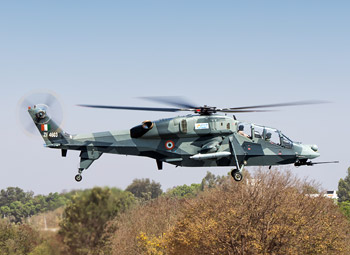INDIAN ARMED FORCES CHIEFS ON
OUR RELENTLESS AND FOCUSED PUBLISHING EFFORTS

SP Guide Publications puts forth a well compiled articulation of issues, pursuits and accomplishments of the Indian Army, over the years

I am confident that SP Guide Publications would continue to inform, inspire and influence.

My compliments to SP Guide Publications for informative and credible reportage on contemporary aerospace issues over the past six decades.
- Interim Defence Budget 2024-25 — An Analysis
- Union Defence budget 2024
- Indian Army: In quest of greater firepower and policy recommendations for gaps
- Indian Army Annual Press Conference 2024
- 6G will transform military-industrial applications
- Tata Boeing Aerospace Delivers 250 AH-64 Apache Fuselages, Manufactured in India
Indigenous LCH — good strides
 |
By Lt. General P.C. Katoch (Retd) Former Director General of Information Systems, Indian Army |

India's indigenous Light Combat Helicopter (LCH), developed by Hindustan Aeronautics Ltd (HAL), was a star attraction at the Aero India 2017 held at Bengaluru last month. The LCH is a 5.8-tonne class combat helicopter armed with a nose gun, rockets, air-to-air and air-to-ground missiles, Heavily armoured and engineered for combat, it has state-of-the-art cockpit with day/night targeting systems for the crew including the helmet pointed sight, with the help of which the pilot can aim just by looking at the target. The nose gun caters for 300 rounds of ammunition of different type, penetrating or high explosives. In addition, it can carry a weapon load of up to 1000 kg. The LCH is fitted with a self-protection suite consisting of radar/laser missile warning systems and counter measures dispensing system (CMDS). Air Chief Marshal Fali Major, former IAF Chief tried out the LCH during Aero India 2017 and later said, "A superb flight on the LCH this afternoon at the Aero India 2017! It was a delight to fly this sturdy and potent machine which handles so well in the entire flight and combat envelope for weapon delivery and other combat missions. My compliments to the HAL and Team LCH". Referring to the 1999 Kargil Conflict, former Wing Commander Unni Pillai, Chief Test Pilot of HAL stated that IAF were hampered as the only combat helicopter, the Mi-35, couldn't operate at extremely high altitudes where most of the conflict was concentrated. "The Mi-35 couldn't even cross the Banihal pass. We were handicapped and badly needed a chopper that can even launch assaults at high altitudes", he added. In the LCH, India now has an indigenous combat helicopter that can carry out operations even at the 19,600-feet high Saltoro Range in Siachen Glacier area.
The first LCH prototype completed its first ground run on 4 February 2010 and its inaugural flight as LCH Technology Demonstrator (TD-1) on March 23, 2010. This maiden flight was 20-minute duration with the helicopter flying at low speed at low altitude and the crew undertaking checks on the systems on board. The second LCH prototype (TD-2), fitted with weaponry, was unveiled at Aero India 2011 in February 2011. It featured substantial weight reductions over the earlier TD-1.The second prototype (TD-2) achieved its first flight on 28 June 2011. The third LCH third prototype (TD-3) made its successful maiden flight on 12 November 2014. TD-3 and TD-4 were extensively used for testing mission sensors, weapon systems and firing trials. Successful cold weather trials of the LCH were carried out in Leh during 2015 in the temperature of minus 18 °C at 4.1 km altitude, to assess high altitude performance and low speed handling. Concurrently, successful hot weather trials were also conducted during 2015 at Jodhpur with temperatures from 39 to 42 °C. In September 2015, the LCH (TD-3) became the first attack helicopter to land in Siachen. The helicopter landed at high altitude helipads at 13,600 feet to 15,800 feet. The weapon firing trials will be held during the middle of 2016, TD-3 fired 70 mm rockets in its weaponized configuration, while TD-4 had completed its first flight on December1, 2015. LCH certification firing trials with integration of mission sensors like the electro-optical system, helmet pointing system and weapon systems, air-to-air missiles, turret gun and rockets were set for July and August 2016. The LCH is intended for use in air defence against slow moving aerial targets like aircraft and UAVs, Counter Surface Force Operation (CSFO), destruction of enemy air defence, escort for special heliborne operations (SHBO), counter insurgency (CI) operations, supporting combat search and rescue (SAR) missions, anti-tank and scout roles. HAL already has firm order to deliver 65 x LCH to the IAF and 114 to the Indian Army. India is reportedly in talks with African nations for possible export of the LCH. The Defence Minister has set a target of $2 billion worth of exports over the next two years. As per HAL's Chief Test Pilot the first limited series of 10 helicopters will be available to the IAF within the next four months.
Photo Credit: Karthik Kumar / SP Guide Pubns





